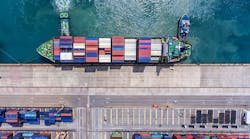OEMs that outsource components to foreign producers will soon learn — if they haven’t already — that their parts are lost at sea.
As more and more suppliers arrange search parties [pun for conduct cost-benefit analysis], significant time and costs associated with shipping are seldom recovered, and the future looks grim for suppliers who have not evaluated onshoring options. In fact, the supply chain impact may be significant as the maritime industry prepares for one of the most significant changes in its recent history: IMO 2020 rules that will be met with escalating costs and operational challenges.
What is IMO 2020? What is the impact?
Starting January 1, 2020, all ships operating in the open sea must comply with stricter environmental regulation set by the International Maritime Organization (IMO 2020), aiming to reduce sulfur oxide emissions from sea vessels by 85%.
Operational challenges will be considerable, and the costs astronomical; with a total global impact in excess of $1 trillion over five years, according to S&P Global Platts Analytics estimates.
While the onus for compliance falls on carriers, price volatility will continue with anticipated service disruptions as thousands of ships are taken out of the market to fit equipment called scrubbers (or a switch to low-sulfur fuel or use of liquidized natural gas). In fact, overall prices of container transportation and freight rates have already increased significantly, including one indicator — the Baltic Dry Index — that surged in September to its highest since November 2010.
Fleets will consider factors such as the age of their vessels, trading routes and locational availability of the various fuel options. However, with concerns around demand outstripping supply, fuel costs will increase along with logistics timelines and availability of shipping. These costs and implications will be passed down to those shipping materials.
What’s the best option for manufacturers today?
We would be remiss to say that there are no benefits to offshoring — but the concept became too common practice. Many companies moved production to low-cost countries, worried that competitors would gain a cost advantage; fixating on a component’s unit price rather than the total cost of ownership, which oftentimes results in a 20 to 30% miscalculation of actual offshoring costs. Some of the most commonly cited costs include inventory carrying costs, shipping, travel expenses, and communications issues, rising offshore wages, as well as intellectual property risks.
Today, many US manufacturers are re-evaluating production and sourcing locations and are realizing major benefits of reshoring for a large volume of high-quality products.
In the molded rubber category, an uptick in reshoring began years ago with motivations tied to quality standards and reducing supply chain exposure. This resurgence was largely due to an unbalanced increase in production costs with a steady, and even declining standard for quality. For example, from 2000 to 2016, indexed manufacturing labor costs increased by 400% in China, compared to only 2% in the US.
In the last year, however, macro trends, trade war realities, and regulations have further made the case clear for onshoring, as OEMs realize the total costs of ownership of Made In USA rubber components to be lower on average and declining.
Because of this — and impending IMO 2020 compliance — the custom molder and OEM partnership will become more important than ever before, and companies that can source a local supplier will gain the advantage.
What to look for in a parts supplier?
When a shipment isn’t crossing international borders or taking a long voyage over water, logistics costs are lower, far less complex and ensure higher confidence of on-time delivery.
Whether doing business locally or across borders, when producing or assembling parts, OMEs should turn to suppliers that can truly address supply chain gaps and overall manufacturability through design enhancements, advanced product quality planning, and material offsets — such as Rahco Rubber.
Time to market can be reduced by leveraging fast prototyping, mold development, and production, with secondary operations. For example, Rahco customers often find it easier and more cost-effective for it to perform various assembly operations. This can range from simple packaging of various components to highly automated cells for part assembly and boxing, rubber part slitting and robotic part removal of molded parts.
Along with automated production processes, OEMs should source vertically integrated suppliers that work as partners. Rahco’s on-staff chemists and engineers work with customers as an extension of their staff to design, improve and optimize parts that meet lifestyle demands, mitigate risk, and help build sustainable, competitive advantages.
What if reshoring isn’t an option?
Of course, there are good reasons to source some products and components from low-cost countries, including producing or sourcing components to meet the demand for products in such foreign markets.
If you continue to do business with foreign manufacturers, make sure they understand the pace needed to launch new products, process efficiency techniques, like the design for manufacturability, and can produce parts to exacting specifications. Don’t sacrifice quality or reliability. Most importantly, your product shouldn’t break or wear out because the components are made poorly. Rahco Rubber helps companies achieve competitive advantages by ensuring parts are made to specification. We work with suppliers from concept inception to product delivery, in full and on time with zero defects.
Rahco is offering a no-obligation, risk-free analysis to not only validate your material formulation but ensure all designs and components are optimized for performance, cost efficiencies and manufacturability.
To learn more, please contact us or take advantage of our Complimentary Testing Services.
In the meantime, we applaud the IMO and those in compliance with the regulations aimed at reducing greenhouse gas emissions, protecting public health and supporting the environment.
Rahco Rubber is committed to the environment, but we also acknowledge that the ever-changing global economy undoubtedly adds new layers of complexity to the supply chain — and there’s no reason your component should be delayed or come at a higher cost.










